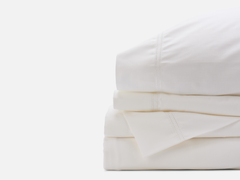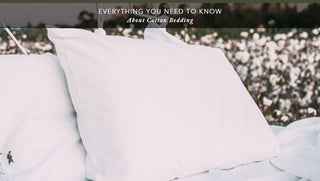The bedding section of any store is loaded with an almost overwhelming number of options, from silky satin sheets to warm flannel quilts. Despite the wide variety of bedding materials out there, cotton almost always comes out as king.
But even narrowing down the bedding section to just cotton sheets can still give you a lot of options to sort through. We’ve compiled a handy list of everything you need to know about cotton bedding to help you sort through the options to find the best bedding for your room.
Benefits of Cotton Bedding
With so many fabric options out there, it makes sense to ask yourself why you should choose cotton. But if there’s one thing you should know about cotton bedding, it’s how many benefits it can offer sleepers. Here are just a few of them:
- Cotton is breathable for a comfortable night’s sleep.
- Cotton sheets are easy to care for.
- Cotton a durable natural fiber.
- Cotton sheets have a tight weave, preventing dust and other allergens from becoming trapped.
- Cotton is biodegradable, making it eco-friendlier than synthetic sheets.
On top of that, the United States is one of the top three cotton-growing countries in the world. That means buying cotton sheets is an easy way to support American businesses.
Types of Cotton
There are four different species of cotton that people grow to sell commercially: levant cotton, tree cotton, Egyptian cotton, and upland cotton. But typically, you’ll see only upland cotton and Egyptian cotton in stores. Knowing the difference between these species will help you have a better idea of what you’re buying.
Egyptian cotton is known for having longer fibers than upland cotton, which makes it durable and flexible. Much of this is marketing though and there is a lot of fraud in the "Egyptian cotton" market. Upland cotton fibers now have qualities that are comparable to Pima or Egyptian. Egyptian cotton is also significantly more expensive to produce, which affects the price.
Upland cotton’s fibers are shorter, which some people say makes it less durable. However, upland cotton has made significant strides in the last few years making it's fiber qualities competitive with Egyptian cottons. Also, it's water resistant, far less expensive to produce, and more affordable for consumers. Upland cotton is also still durable when you treat it with care, allowing you to get several years of your sheets.
Types of Cotton Bedding
When people think of bedding, they often focus their attention on sheets. However, bedding can refer to anything you put on your bed. So if you want to know everything to know about cotton bedding, it pays to look at every kind of bedding.
Sheets
Thread Count
Thread count refers to how many threads are woven into a square inch of fabric, ranging from 200 to 1,000 or more. Typically, sheets with a high thread count feel smoother on the skin. However, that doesn’t automatically make them better for every sleeper. This is especially true if you’re a hot sleeper. Sheets with a lower thread count tend to be lighter and more breathable, which keeps you from waking up sweating in the middle of the night.
Types of Weaves
From a distance, sheets just look like wide, uniform pieces of fabric. But if you were to look closely at any piece of fabric, you’d discover that each one is woven together with a different pattern. Different types of weaves will affect sleepers’ experiences differently. Some types of weaves include:
- Sateen: A weave known for its silky texture, high thread count, and warmth
- Jersey: A weave associated with shirts and a comfortable, broken-in feeling
- Flannel: A warm, plush, textured weave that’s popular in the winter
- Twill: A weave with diagonal ribbing across the surface
- Percale: A sturdy weave that combines a light weight with a smooth texture
Percale and sateen tend to be the most popular weaves for bedsheets. Which you choose comes down to preference. Sateen sheets are smooth, but they can become uncomfortable if the weather is warm or you’re a hot sleeper. That’s why we tend to favor percale, which offers the best of both worlds.
Covers
When it comes to the warm outer covering that goes over the sheets, people usually choose between three options as far as cotton bedding goes. Some people use the terms for coverings interchangeably, but there are actually quite a few differences.
Quilts
Nothing feels like home quite like a quilt does. But it isn’t just the comforting patterns or the memories of picnics with our grandparents that make a quilt a quilt. A quilt is made up of three layers. On the outside there are front and backing, and in between the two is a cushioned layer called the batting. These three layers are what give quilts that sturdy feeling, comforting you when you wrap up in them. But because the layers are so light, quilts make great choices for people who tend to feel hot in the middle of the night. Quilts also lend themselves well to people who like to layer multiple blankets on their beds.
Duvets
A duvet also has three layers. But while quilt batting tends to consist of thin layers of cotton, duvets are usually stuffed with down, which gives them a puffy look that’s fun to sink into. This also makes them much warmer for the winter months or for people who tend to get cold at night.
People tend to mix up duvets with their cousin the comforter because they’re both made up of three layers with a puffy middle. But duvets tend to be filled with a little more down than comforters, and they also have a second component that sets them apart: a duvet cover that you can change out or use as a separate blanket.
Blankets
People often call anything they wrap up with to warm up a blanket, whether it’s a quilt, duvet, or comforter. But technically speaking, a blanket is made of only one layer. One measly layer may not be ideal on a chilly winter night, but using multiple blankets can help you maximize your bed’s comfort.
For example, let’s say your quilt is not quite warm enough. Adding another three-layer quilt may push you over the edge to sweltering territory, but one extra blanket may be just the thing to keep you comfortable. Besides, an extra throw blanket at the end of the bed adds a little extra pop of color, giving your whole room some added visual interest.
Whether you’re looking for a new cover for your duvet or American-made luxury cotton sheets, Red Land Cotton has everything you need to help you make your next bedding choice.



